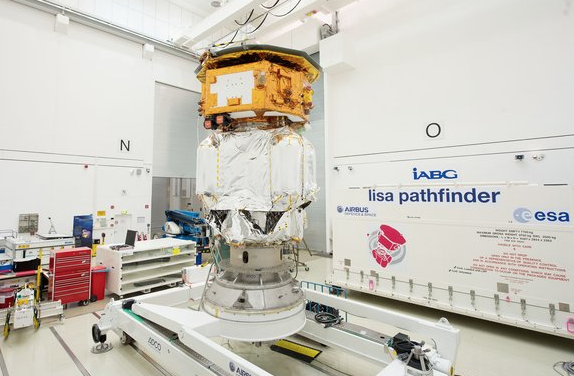[SatNews] The interferometer can measure the relative position and orientation of the masses, which are around 40 centimeters from each other, to an accuracy of less than one millionth of the width of a human hair, which is less than 0.01 nanometer...
LISA Pathfinder, ESA’s gravitational-wave detection technology demonstrator, is ready to be shipped to Kourou in French Guiana in preparation for its launch in November.
Airbus Defence and Space has completed a series of intensive tests on LISA Pathfinder’s propulsion and science modules at IABG, near Munich, to prove its space worthiness. The 1.9-tonne spacecraft, primed by Airbus Defence and Space will be launched on a European Vega rocket.

LISA Pathfinder launch composite at IABG’s space test center
“LISA Pathfinder is a remarkable project to test the ultra-high precision technologies that will be needed to detect gravitational waves in space. Albert Einstein predicted that the waves exist, but so far none have been found. LISA Pathfinder will take us one huge leap nearer to finding them,” said Michael Menking, Head of Earth Observation, Navigation and Science programs at Airbus Defence and Space.
LISA Pathfinder carries the LISA Technology Package (LTP), which weighs around 150 kilograms. It consists of a laser interferometer measuring changes in the distance between two precision-engineered gold/platinum test masses, each weighing 1.96 kilograms. Once in orbit around the first Earth Sun Lagrange point, 1.5 million km from Earth, the two test masses will be released from a locking mechanism and held in position with a weak electrostatic field that can be very precisely controlled.
Once in science mode, the electrostatic actuation of the primary test mass is switched off. The spacecraft is then controlled, via the drag-free and attitude control system, to follow the test mass.
The laser interferometer and electrostatic sensors will track the motion of the test masses inside the spacecraft, ensuring they remain undisturbed. The interferometer can measure the relative position and orientation of the masses, which are around 40 centimeters from each other, to an accuracy of less than one millionth of the width of a human hair, which is less than 0.01 nanometer.
The LISA technologies also include two types of tiny thrusters so small that a thousand would be needed to lift a sheet of paper on Earth. The mission will carry out in-orbit testing of these micro‑propulsion systems, as well as an additional drag-free control system from NASA and several innovative technologies associated with the payload.
ESA has selected the gravitational universe science theme for its third Large Class L3 mission, for which a LISA-like mission is a leading candidate. Gravitational radiation will allow astronomers to study our universe in a new way and future telescope systems will be able to observe exotic sources, such as colliding super-massive black holes, as never before.
LISA Pathfinder is paving the way for a future large space observatory that ultimately will directly observe and precisely measure gravitational waves. These minute distortions in space-time require very sensitive and highly precise measuring technology, the performance of which can only be tested in a space environment.
Airbus Defence and Space in the UK was chosen by the European Space Agency (ESA) to build the LISA Pathfinder and is responsible for delivering the integrated turnkey satellite. Airbus Defence and Space in Germany has been commissioned by ESA and the German Aerospace Center, DLR, as the systems leader for the LTP, which was developed with contributions from European research institutes and companies.

